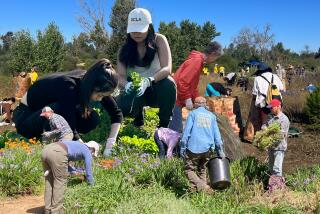Hunting and Gathering : * Alimentary adventurers enrolled in ‘Discovering Edible Wild Plants’ learn that weeds, thistles and dandelions make a satisfying repast.
- Share via
I knelt on the damp ground at Pierce College, poking through scraggly grass, picking at weeds and nibbling on plants. I was foraging for my next meal.
“Check the back of the leaf before you eat it--unless you want insects in your lunch,” warned Hilla Futterman, who teaches the “Discovering Edible Wild Plants” class I was attending along with a dozen other wanna-be naturalists. I inspected the remainder of the plant I had just gulped down. It was covered with tiny orange bugs.
Under normal circumstances, I would have screamed. At the very least, I would have gagged. But realizing an ingested insect or two wouldn’t elicit so much as a raised eyebrow from this crowd, I philosophically decided that I could use the protein. After all, I was here to appreciate nature’s bounty. Getting grossed out would be rude.
Weeds and wild plants are serious stuff to Futterman, 56, who has spent the past 20 years escorting students on mountain trails, city streets and college campuses to identify, gather and prepare wild food.
“Wild plants are everywhere,” she explained. “And when a plant grows where it is supposed to grow, it is a true health food.”
Futterman got us in the mood for greens by reciting a Carl Sandburg poem titled “Weeds” and reading a biblical passage about the Garden of Eden. Then she paused.
“Let us gather,” she said reverently. Determinedly holding our empty grocery bags like hopeful, albeit overgrown trick-or-treaters, we set out in search of salad. Futterman led us to a patch of weeds. “This little plant is so hated,” she said, holding up a dandelion. “But it has more vitamin A than any green you can find in the grocery store.”
She showed us how to rip sow thistle leaves off the stalk and instructed us to look for young, tender plants that have not yet begun to flower.
I spotted two bugs crawling on a particularly tasty looking leaf and boldly tossed the plant--critters and all--into my lunch sack.
After collecting a handful of yellow flowers to top our salads (who needs croutons?), we got up and marched along a shady trail for our next course.
We stopped to pick a dark, hairy plant called mallow. Its root can be simmered to make a soothing broth for sore throats, but we were going to cook it up in a soup.
I bit into a leaf, but it was too furry for my taste.
Next we picked curly dock, a rhubarb relative with long, lance-shaped, wavy leaves. Like spinach, it shrinks when cooked, so Futterman asked us to gather as much as possible. Just as my bag was bulging, a tiny gray mouse popped up from the area I was foraging in and scampered over my sneaker.
We walked on, picking, sampling and collecting various plants while Futterman extolled their virtues. Purslane is good cooked, stir-fried, pickled and raw, she said. Gray mustard flowers are perfect salad toppers. Lamb’s-quarters are loaded with calcium. The seed pods of wild radishes are hot and tangy. Spicy black mustard leaves taste terrific in sandwiches.
We came upon a field of green chard. “This is 75 cents a bunch at the market,” Futterman noted. “Think of the money you can save.”
Several of us pounced on the ground and grazed like hungry cows. “Mmmm,” we said. “Delicious.”
We gathered in a picnic area to prepare our meal. While we students shredded greens and separated them into salad bowls and soup pots, Futterman bustled about, slicing a carrot into the sow thistle-and-dandelion salad, chopping a potato into the bland mallow soup, adding a fat chunk of butter to a steaming bowl of curled dock, whipping up a quick acorn-and-onion hash and decorating the table with bright sprigs of holly berries. Some students brought acorn bread and toyon-apple pie, prepared from nuts and berries collected during the previous week’s hike.
Everything smelled and looked wonderful. We dug in and marveled over our bountiful feast--bugs and all.
Where and When What: Class on “Discovering Edible Wild Plants” offered through Pierce College Extension. Classes meet in and around the Santa Monica Mountains.
Hours: 10 a.m. to noon Feb. 19 and 26, and March 5 and 19.
Price: $34 for all four classes.
Call: (818) 719-6425.
Box for page






